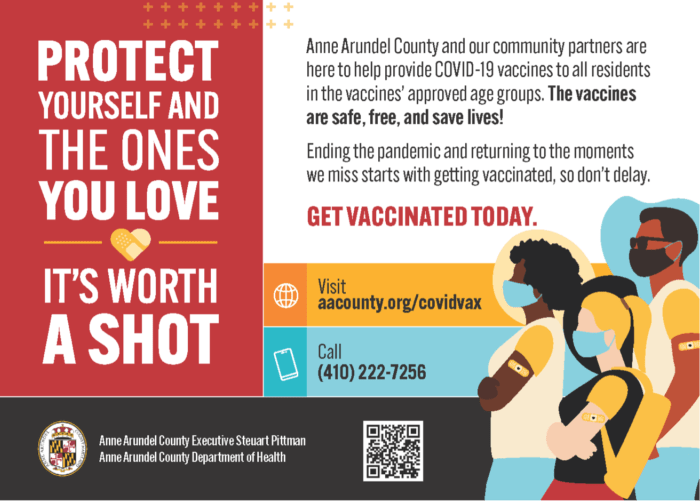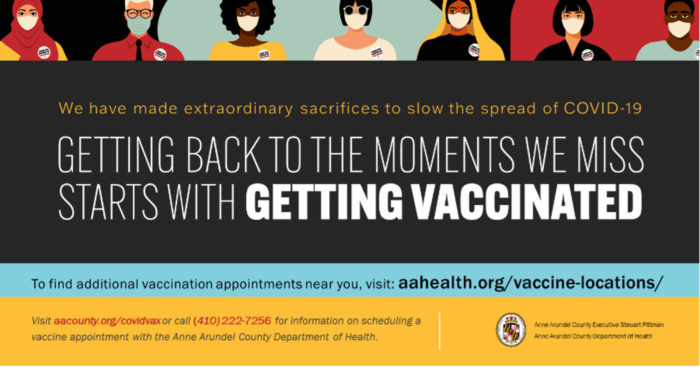
Strategies for Successful COVID-19 Vaccine Communication
By Kate Austin, Senior Director
In Anne Arundel County, Maryland, over 600 residents have died from COVID-19, and nearly 44,000 cases have been confirmed. Like most places in Maryland, the U.S., and the world, the virus spread rapidly within the county, closing schools, businesses, and upending residents’ way of life for the past 15 months.
Staying home, social distancing, wearing a mask, and now, importantly, getting vaccinated became new public health directives for county residents to help stop the spread of the virus. But residents’ willingness to follow them requires trust and effective communications, especially when misinformation is abundant and public trust, fragile.
Starting in February 2021, Hatcher had the privilege of supporting Anne Arundel County, including its Department of Health, in developing and executing a centralized communications strategy to educate, inform, and inspire all residents to get the COVID-19 vaccines and, in particular, community members that have been hit hardest by the virus – African Americans, Latinx, and economically distressed residents.
Developing a vaccine communications strategy, targeted messaging in multiple languages, and a massive amount of campaign collateral in a short amount of time required a large team of dedicated public health communications experts, graphic designers, video producers, and digital media specialists who understand behavior change, can quickly adapt to shifting guidance and public sentiment, and who know the community they are trying to reach. The Hatcher team was eager and ready to take on this challenge because we, too, are Anne Arundel County and Maryland residents who want the best for our families, our communities, and our state.
The project has been a gratifying and challenging experience. We’ve learned a lot about what motivates residents to take action to protect their health, and other critical lessons that have helped bring the county’s vaccination rate to almost 70% of eligible residents. Here are just a few elements of our collective success.
Consistent messaging is key. An often-said proverb during this project is that public health moves at the speed of trust. In other words, ending COVID-19 through widespread vaccination is dependent on building confidence, trust, and buy-in from all county residents. For the reluctant and distrustful, it requires communication strategies that speak to their specific concerns, take into account a range of health literacy, and are consistent across earned, owned, and paid communications channels.
For this project, we began by establishing messaging that tackled those concerns head-on, whether it be the speed at which the vaccines were developed, fears about side effects, or confusion about eligibility.
The foundational messaging we developed for each audience – including the tagline, “Protect the Ones you Love. It’s worth a shot.” – is used across all platforms, including by spokespeople and community partners, print posters, paid advertising, social media, and video.
Our award-winning designers and in-house video production team created compelling collateral that places critical information front and center while coming to life with photos of county residents, testimonials, and data visualization.


Lead with empathy. In behavior change communication, we know that using shame, guilt, or fear is ineffective. In the case of the COVID-19 vaccines, this is especially true. People are scared and have legitimate questions about the vaccines and their safety. Knowing we need to meet each audience where they are, we lead most of our communications with empathy – acknowledging people’s hesitancy and providing scientific, unbiased answers without judgment. We also frame our calls to action around what they have to gain from getting vaccinated rather than what they could lose. The decision to get vaccinated is theirs to make, but highlighting moments of missed connection serves as a reminder that vaccination is the pathway to regaining these moments.


Use trusted messengers. People act when they trust the messenger, the message, and their motivations. The most effective messengers of vaccine information are people from within the community. Working with the county’s team of community liaisons, we’ve identified faith leaders, health experts, and civic influencers to serve as ambassadors of information about the vaccines.
We created public service announcements – in English and Spanish – and social media-friendly video testimonials that focus on the importance of getting vaccinated and address common public misconceptions that we track through social listening.
Quality assurance checks are done for all translated materials to convey the information in an accurate, nuanced, and culturally sensitive way.
Adapt, adapt, adapt. If there is one skill we used more than any other throughout this project, it would be our ability to adapt. The speed at which information about the vaccines, residents’ eligibility, and where to access vaccines changed from day to day was staggering. Over four months, we’ve moved from communicating about a pre-registration system where residents waited for notification of their eligibility to widespread access (including children 12 and older) and more supply than demand. Today, we promote incentives to get vaccinated, like lottery systems or gift cards from businesses. Several weeks ago, those types of activities would have been furthermost from our minds.
Every day, we ask ourselves, what will it take to reach everyone in our community with the latest information, whether they’re highly digital savvy or need traditional direct mail or in-person contact? Answering that question means adjusting messaging, tactics, and delivery methods daily. We have to be nimble and adaptive to refine our modes of outreach, including adding paid media (programmatic ads, Facebook ads, streaming radio, transit, and direct mail) mid-way through the project to bring information to residents where they access it and to make it as easy as possible to get vaccinated.
Ending one of the greatest health crises in American history is ultimately a collective responsibility. All of us – individuals, communities, governments, and the private sector – have a role to play in helping to turn the tide against the pandemic and bring our lives back to normal. It’s been a privilege to work alongside the dedicated public servants of Anne Arundel County on this important project, doing our part to stop COVID-19. Because protecting the ones we love is worth a shot.